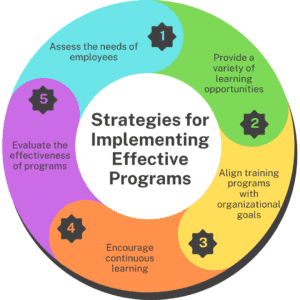According to The Society for Human Resources Management (SHRM), replacing employees can cost up to 50-60% of the employee’s annual salary, with total costs equivalent to 90-200% of their annual salary. This is why retaining top talent is key to keeping your business on the right track, especially in a competitive market.
One of the key strategies for improving retention rates is through the implementation of learning and development programs. According to a 2021 survey conducted by Gallup, 66% of workers ranked learning and development opportunities as one of the top three benefits they look for in a company. So, not only can these programs help to retain workers, but also to attract them.
Doherty Staffing Solutions is an expert when it comes to employee retention. In this article, we will cover the importance of offering employee learning and development opportunities, their benefits, strategies for implementing effective programs, how to measure success, and lastly, how to create a culture of continuous learning.
The Importance of Employee Learning and Development Opportunities
Employee learning and development opportunities play a crucial role in enhancing retention rates within an organization. When employees are given opportunities to grow and develop their skills, they feel valued. When workers have a sense of company investment in their personal and professional development, their motivation and commitment to the organization increases, leading to higher retention rates.
By offering training and development programs, organizations demonstrate their commitment to the growth of their employees, and consequently, their business’ success. Providing these programs creates a win-win scenario for both employees and the companies they work for. Developing a positive work environment where workers feel supported and empowered to reach their full potential makes them more likely to stay with the organization long-term.
Furthermore, learning and development opportunities help workers stay engaged and motivated in their roles. When employees have the chance to acquire new knowledge and skills, they can apply them in their work, leading to increased job satisfaction. In fact, 71% of surveyed workers in a Gallup study said that job training and development opportunities increased their job satisfaction, with 61% stating that upskilling opportunities are one of the top reasons they remain at their current employer. This goes to show that learning and development opportunities not only improve retention rates but also enhance overall productivity and performance within the organization.
Benefits of Learning and Development Opportunities
There are several benefits of providing learning and development opportunities to workers.
First, it allows employees to acquire new skills and knowledge, enabling them to perform their jobs more effectively. This leads to increased job satisfaction and a sense of accomplishment.
Second, learning and development programs contribute to the growth of employees. When workers feel that they are continuously learning and improving, they are more likely to be engaged and motivated in their roles.
Third, investing in employee development can help organizations attract and retain top talent. Workers are more likely to choose an organization that prioritizes their growth and development over one that does not provide such opportunities.
Last, but certainly not least, learning and development programs contribute to a positive company culture. When workers see that their organization values their development, it creates a sense of loyalty and commitment, leading to higher retention rates. Plus, growth opportunities can even improve employees’ sense of well-being, and, according to Forbes contributor Garen Staglin, “Every $1 investment in mental health improvement programs has a $3 to $5 ROI.”
Strategies for Implementing Effective Employee Development Programs
To implement effective learning and development programs, organizations can consider the following strategies:
- Assess the needs of employees: Conduct surveys or interviews to understand the specific skills and knowledge gaps that workers have. This will help in designing targeted training programs.
- Provide a variety of learning opportunities: Offer a mix of in-person training, online courses, workshops, and mentorship programs to cater to different learning styles and preferences.
- Align training programs with organizational goals: Ensure that the content of the training programs is aligned with the strategic objectives of the organization. This will help workers see the relevance and value of the training.
- Encourage continuous learning: Foster a culture of continuous learning by promoting self-directed learning, sharing of knowledge within teams, and providing resources for further development.
- Evaluate the effectiveness of programs: Regularly evaluate the impact of training programs on employee performance and satisfaction. Use feedback and data to make improvements and adjustments as needed. Continue reading to discover more specifics about evaluating and measuring the success of these programs!
Measuring the Success of Employee Development Initiatives
Measuring the success of employee development initiatives is crucial to ensure their effectiveness and identify areas for improvement. Depending on the program, measurement can vary. For instance, peer reviews or customer feedback can be used to measure soft skills, while more technical or functional training can be directly linked to team performance.
One way to measure success is by tracking retention rates and comparing the retention rates of employees who have participated in development programs versus those who have not. If the retention rates are higher for the trained employees, it indicates that the programs are contributing to employee engagement and retention.
Another metric to consider is employee satisfaction. Conduct surveys or interviews to gather feedback from workers about their experience with the development initiatives. Positive feedback and increased satisfaction scores indicate that the programs are meeting the needs and expectations of employees.
Additionally, organizations can assess the impact of development programs on employee performance. Be sure to measure key performance indicators (KPIs) related to the skills and knowledge acquired through the programs. If there is a noticeable performance improvement, it indicates that the programs are effective.
Overall, a combination of quantitative and qualitative measures should be used to evaluate the success of worker development initiatives and make data-driven decisions for improvement.
Creating a Culture of Continuous Learning
Creating a culture of continuous learning is essential for maximizing the benefits of learning and development opportunities and improving employee retention rates.
To create such a culture, organizations can:
– Encourage workers to set learning goals and regularly update them.
– Provide dedicated time and resources for learning activities.
– Recognize and reward employees who actively engage in learning and development.
– Foster a supportive environment where employees feel comfortable asking questions and seeking feedback.
– Encourage knowledge sharing and collaboration among employees through team projects and cross-functional initiatives.
By promoting continuous learning, organizations can empower employees to take ownership of their professional development and create a positive work environment that supports growth and retention.
After reading this article, we hope that you are more well-informed about how learning and development opportunities can improve your company’s retention rates. Doherty Staffing Solutions has extensive experience in partnering with businesses to help them improve retention rates through customizable, strategic workforce solutions. If you are seeking help retaining and attracting top talent, contact us today!





